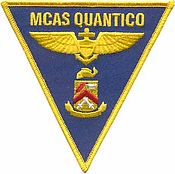- Marine Corps Air Facility Quantico
-
Coordinates: 38°30′13″N 077°18′18″W / 38.50361°N 77.305°W
MCAF Quantico
Turner Field
Old MCAS Quantico logo IATA: NYG – ICAO: KNYG – FAA LID: NYG Summary Airport type Military Operator United States Marine Corps Serves Marine Corps Base Quantico Location Quantico, Virginia Built 1919 In use 1919 - present Commander LtCol Brian L. Magnuson Occupants HMX-1 Elevation AMSL 10 ft / 3 m Coordinates 38°30′13″N 77°18′18″W / 38.50361°N 77.30500°W Website Map Runways Direction Length Surface ft m 2/20 4,237 1,291 Asphalt Sources: Official site[1] and FAA[2] Marine Corps Air Facility Quantico (MCAF Quantico) (ICAO: KNYG, FAA LID: NYG) is a United States Marine Corps airfield located within Marine Corps Base Quantico, Virginia. It was commissioned in 1919 and is currently home to HMX-1, the squadron that flies the President of the United States. The airfield is also known as Turner Field, after Colonel Thomas C. Turner, a veteran Marine aviator and the second director of Marine Corps Aviation,[3] who lost his life in Haiti in 1931.
Contents
History
Aviation first arrived at Quantico in July 1918, when two kite balloons were flown to spot artillery fire. These forerunners of today's spotter aircraft were soon augmented with the assignment of four seaplanes, which operated from the muddy junction of Chopawamsic Creek and the Potomac River.
In 1919, a flying field was laid out and the land leased to accommodate a squadron returning from World War I combat in Europe. The facility was later named Brown Field, in memory of 2ndLt Walter V. Brown, who lost his life in an early accident at that location. The present site was selected in 1931, when larger and faster planes brought recognition of the limitations and hazards of Brown Field - its single, crosswind runway, bound by trees, hills, swamp, a high tension line and a railroad.
A new airfield was constructed by changing the course and flow of Chopawamsic Creek and reclamation of the marshland from that area. The new facility was named Turner Field.
By 1939, four squadrons — 68 bombers, scout bombers, fighters, transports, utility and observation planes — were based at the airfield. On December 1, 1941, the field was named Marine Corps Air Station Quantico, and placed under operational control of the Commanding General, Marine Barracks.
In 1947, Marine Helicopter Squadron One was established at Quantico to pioneer an entirely new concept in air operation; to evaluate and test, in coordination with the Landing Force development Center, the theory of carrying troops to the battle zone by helicopter.
By the close of the Korean War, helicopters had gained permanent acceptance by the military for tactical and logistical support operations. Effective 15 November 1976, MCAS Quantico was re-designated as Marine Corps Air Facility (MCAF), Quantico, Virginia. MCAF Quantico is currently the home of Headquarters Squadron (HqSqn), Marine Helicopter Squadron One (HMX-1), and home to Marine One.
HMX-1, in addition to its tactical development mission, flies the President of the United States and provides helicopter support for the Marine Corps Combat Development Command.
On 1 October 2005, MCAF Quantico was reorganized under the Commanding General, Marine Corps Installations East, headquartered at Marine Corps Base Camp Lejeune, North Carolina.
See also
References
- This article incorporates text in the public domain from the United States Marine Corps.
- "MCAF History". MCAF Quantico, United States Marine Corps. http://quantico.usmc.mil/activities/display.aspx?PID=2081&Section=MCAF. Retrieved 2007-11-08.
- Shettle Jr., M. L. (2001). United States Marine Corps Air Stations of World War II. Bowersville, Georgia: Schaertel Publishing Co.. ISBN 0-964-33882-3.
Notes
- ^ MCAF Quantico, official site, retrieved 2007-11-12
- ^ FAA Airport Master Record for NYG (Form 5010 PDF), effective 2007-10-25
- ^ "Directors of Marine Corps Aviation, 1919-1962". History of Marine Corps Aviation. AcePilots.com. http://www.acepilots.com/usmc/main.html. Retrieved 2007-11-19.
External links
- MCB Quantico, official website
- MCB Quantico at GlobalSecurity.org
- Resources for this U.S. military airport:
- AirNav airport information for KNYG
- ASN accident history for NYG
- NOAA/NWS latest weather observations
- SkyVector aeronautical chart for KNYG
Operational military installations of VirginiaDepartment of Defense  Headquarters
Headquarters
Army  FortCampPlantRadford Army Ammunition Plant
FortCampPlantRadford Army Ammunition PlantMarines  Air StationMarine Corps Air Facility QuanticoHallHenderson Hall
Air StationMarine Corps Air Facility QuanticoHallHenderson HallNavy  StationShipyardNAS OceanaMedical CenterSchoolFleet Training Center Dam Neck
StationShipyardNAS OceanaMedical CenterSchoolFleet Training Center Dam NeckAir Force 
National Guard  Langley AFBState ReserveSchool
Langley AFBState ReserveSchoolCoast Guard  Categories:
Categories:- 1919 establishments in the United States
- Military facilities in Virginia
- Buildings and structures in Stafford County, Virginia
- United States Marine Corps air stations
- Airports in Virginia
Wikimedia Foundation. 2010.


